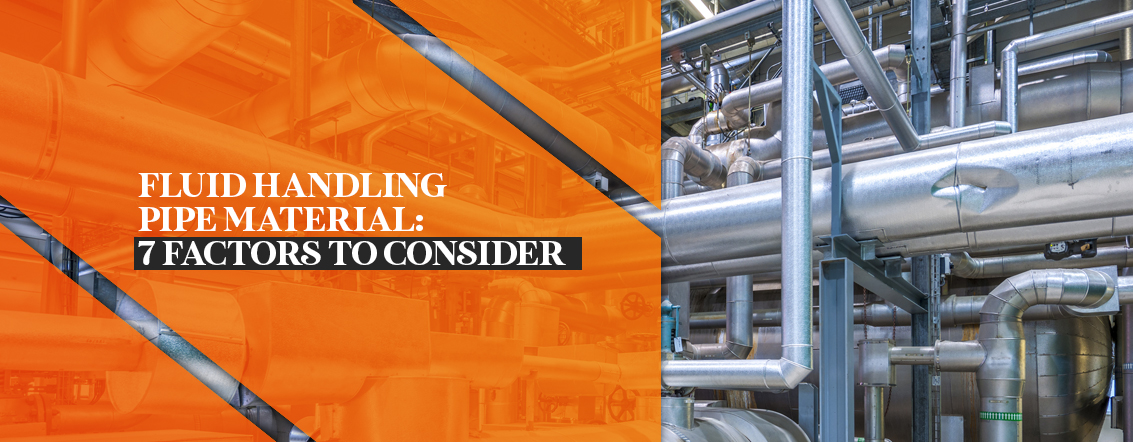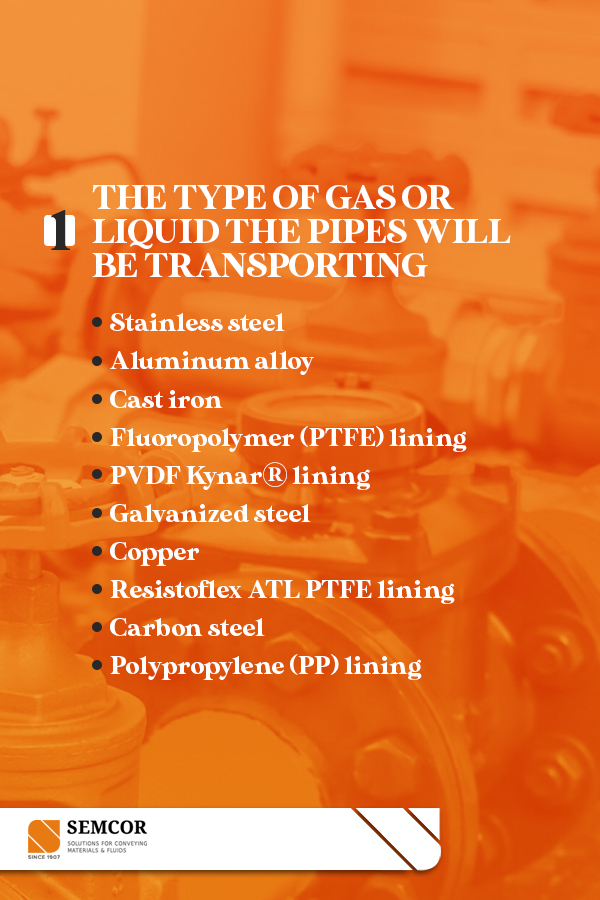Selecting the Right Pipe Material
How to Select the Right Pipe Material for Fluid Handling Operations
At manufacturing plants and other industrial locations, many parts are involved in the success of the entire operation. One of those components is the fluid handling system throughout the building — the piping that runs along the walls, ceiling and potentially underground to provide the facility with water, oil and other fluids that are necessary to complete certain processes.
Like any system, the pipe and fittings involved in your fluid handling operations will eventually need to be replaced. If you’re building a new facility, you get to start from scratch and choose the best piping material for your needs. Whether you’re replacing your fluid handling system or installing one at a brand-new building, there are several factors you should consider before starting, as well as multiple pipe material options to choose from.
When implementing or constructing a fluid handling system in your plant or warehouse, you will have to make several decisions based on your industry, handled materials and objective. One of the most important decisions you will make during this process is the type of pipe material you need to transport your liquids, gases, chemicals and other fluids. This is not a decision to make lightly — the wrong pipe material could jeopardize the quality of your product, as well as the safety of you and your employees.
Here are seven factors to consider when choosing the best pipe material for your fluid handling system.
8 Elements to Consider When Selecting Pipe Material
The material of the pipes in your fluid handling system has a direct impact on the overall success of the system, as well as your facility’s overall mission or goal. It’s critical to weigh all your options and account for the multiple factors that will affect the oil and water pipe material selection process. Here are eight things to consider before you choose your fluid handling pipe material.
1. Material Being Transported
What type of liquid are your pipes transporting? More specifically, is the liquid corrosive or non-corrosive? Corrosive liquids include substances such as crude oil, ammonia, seawater and other acidic liquids that have a heavy chemical makeup. These liquids require a corrosion-resistant pipe material such as a plastic CPVC pipe or lined pipe. Since most liquids are at least slightly corrosive, you will need a corrosion-resistant material for the pipes that will transport it. Meanwhile, non-corrosive fluids or gases like lube oil, air and nitrogen are safe to transport via carbon steel or metal pipelining.
The type of liquid or gas your pipe system transports plays a significant role in choosing fluid handling pipe material. Some pipe materials are better suited for non-corrosive liquids, like oils or standard wastewater. More corrosive liquids, like acid or peroxide, require a pipe with an interior that can hold up to the abrasiveness of these corrosive materials. Corrosive materials are common in many industrial cleaning solutions, as well as in chemical manufacturing and handling. Remember, despite a plastic or metal pipe material’s durability and corrosion resistance, chemicals, acids and saltwater are much more abrasive than standard water or oil. Always keep the liquid you are transporting in mind when selecting a pipe material.
Take a look at how the following popular pipe and pipe lining materials stand up to corrosion:
- Stainless steel: It’s called “stainless” steel for a reason — stainless steel does not rust or corrode as quickly or easily as other materials. It naturally resists most corrosion because it consists of several different alloys, all of which help form a protective oxide layer on the surface. This natural layer is tough and durable. For this reason, it is an ideal water pipe material selection that is also suitable for oils and some chemicals.
- Aluminum alloy: Aluminum does not rust, which is useful when you need your transported liquid to remain pure and uncontaminated. It can handle exposure to many gases, oils and liquids without deteriorating. However, aluminum does corrode over time, especially in saltwater or sulfuric applications.
- Cast iron: Cast iron is easy to find and is uniquely durable against many external sources of corrosion, like plant growth and soil, because it is so thick. Cast iron can withstand water and saltwater for short periods, so it could be suitable for short-term projects. However, it does corrode and rust after prolonged water exposure.
- Fluoropolymer (PTFE) lining: PTFE pipe lining is non-reactive and very resistant against corrosive chemicals. It is one of the most universally applicable pipe lining materials, and thanks to its durability and zero-risk of product contamination, it is the perfect acid, water, chemical and oil pipe material selection.
- PVDF Kynar® lining: PVDF pipe lining is very durable and strong, and is one of the most abrasion-resistance materials on the market. Manufacturing facilities or plants that handle high-strength acids, chemicals, saltwater and nuclear materials find success with PVDF lining. It also resists corrosion from natural sunlight and weathering.
- Galvanized steel: For short-term saltwater projects, galvanized steel is a suitable pipe material, as it does not rust. However, it will corrode after prolonged exposure to both salt and water. Also worth noting is that galvanized steel often corrodes from the inside out, so it may be challenging to detect.
- Copper: Copper is widely used due to its ready availability and aesthetic appeal. It is not completely immune to corrosion, but it is more corrosion resistant than many other materials, such as galvanized steel. Copper is most prone to corrosion in fresh and saltwater, as well as particularly harsh chemicals and acids.
- Resistoflex ATL PTFE lining: ATL PTFE pipe lining contains specially formulated resins that make it very strong and durable during prolonged exposure to saltwater and aggressive chemicals. It is often used in paper processing and power generation plants, as well as in the service industry.
- Carbon steel: Although carbon steel is ideal for high-temperature fluids, it does corrode easily under high levels of exposure to moisture, chemicals and acids.
- Polypropylene (PP) lining: PP pipe lining is a good high-temperature pipe material as it performs very well in temperatures as hot as 225 degrees, as well as saltwater and both basic and acidic applications. However, it does not withstand solvents, volatile organic compounds (VOCs) or excessively low temperatures. PP lining is often used in water treatment facilities, chemical processing plants, power generation facilities and food and beverage manufacturing.
2. Temperature of Liquid Passing Through
The next thing to consider is the temperature of the liquid in your fluid handling system. If you’re transporting high-temperature liquids, you’ll need to be sure your system consists of high-temperature pipe materials. Certain types of plastic piping may not be ideal for handling high temperatures, while others may be designed to handle fluids no matter how hot they are. Metal pipe materials are typically wise choices for high-temperature liquids, although some types may become too hot to the touch.
If you are handling extremely high or low-temperature fluid — including cryogenic liquids— make sur

e your pipe consists of material intended for extreme temperatures. Otherwise, you risk damaging or corroding your pipes and contaminating the liquids inside of them. In some cases, extreme temperatures can break your piping entirely, resulting in expensive repairs, damaged product and hazardous workplace conditions. Metal pipe material is usually suitable for extremely hot liquids, although you and your employees should exercise caution when working with them. Depending on the temperature, aluminum is often used to transport cryogenic liquids.
Your piping material must support these temperatures as well as maintain them throughout the liquid transfer process. In many applications — including laboratories, food processing, medical facilities and plants that work with hazardous chemicals — precise temperatures are required for all liquids and vapors used.
Some pipe materials that can be suitable for high temperatures include carbon steel, as well as PTFE, PVDF, ATL PTFE and PP pipe linings. For extremely low temperatures, copper, some aluminum alloys and high-alloy austenitic stainless steel are least likely to become brittle and break.
3. The Pressure of the Liquid Handling Process
What is the pressure of the fluids your system is handling? If the pressure of these service fluids is very high, you will need piping material that is either high-strength, higher thickness or designed to resist high-pressure fluids. The average pressure that most manufacturing facilities’ piping must be able to handle is around 150 pounds per square inch gauge (psig). If your facility is working with liquids of higher pressures than this, you may have to request a piping material that is specially designed to handle high-pressure fluids.
Various liquids and gases create different pressures inside of your fluid handling pipes. For example, cryogenic fluids are known for creating very high-pressure environments during the transfer process. Many external factors can impact this pressure, too, including the temperature and elevation of your piping.
Some liquids and gases that might require pressure-specific pipe materials include:
- Ammonia
- Chlorine
- Propane
- Carbon dioxide
- Nitrous oxide
- Acetylene
- Butane
- Hydrogen
- Helium
- Neon
- Nitrogen
- Concentrated oxygen
Make sure you choose a pipe material that is rated for high-pressure or low-pressure substances and conditions. If you use a high-pressure liquid or gas in a pipe that is not suited for high-pressure handling, you risk leaks, pipe bursts, flooding, fire, explosion and injury to property and personnel.
Never assume your fluid handling system is adequate for high-pressure substances. Always ask your pipe provider if your fluid handling system is designed to handle high-pressure fluids and vapors before use.
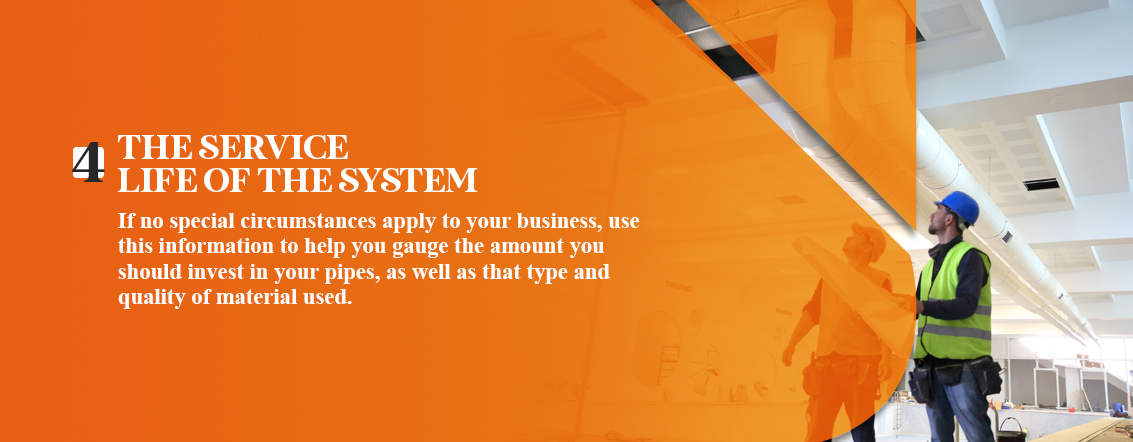
4. Service Life of the Fluid Handling System
You need reliable and durable piping, but how long do you need your fluid handling system to last? A major component of effective piping design and material selection is asking how long you expect your fluid handling system to last. If you know you’ll likely have to replace the system in five to 10 years due to another reason, such as relocation, you don’t need to invest in a very long-lasting piping material. This may also affect how much money you’re willing to spend on the system, which will, in turn, impact the type of material you should choose.
If, on the other hand, you expect this system to last for 10 or more years, you should invest in the most durable type of piping material.
For example, temporary worksites or processing plants that do not typically deal in fluid handling may not need as intricate or durable a system as a permanent plant that transfers fluids daily. You should also factor in how often your business will use your fluid handling system. Of course, there are some conditions — such as extremely corrosive chemicals, hazardous materials or fluids that need temperature regulation — that will require certain pipe materials, regardless of the desired service life of your system. If no special circumstances apply to your business, use this information to help you gauge the amount you should invest in your pipes, as well as that type and quality of material used.
5. Ease of Maintenance
Just like flooring, countertops and other solid surfaces, certain types of piping material are easier to clean than others. Ask yourself how often you can clean your fluid handling system. Be realistic about the frequency, as it is can become a very time-consuming task depending on the size and intricacy of your system. If you won’t be able to clean it very often, having a low-maintenance piping material should be a priority for your facility.

Make sure the material you choose for your fluid handling pipes is maintainable under your current circumstances. There are three main types of maintenance that all fluid handling systems should consider:
- Preventive maintenance: Preventive maintenance is necessary for all parts of your fluid handling system, and should be performed at regularly scheduled intervals based on the approximate cost of downtime, potential risks of system failure, expected time between part repairs and availability of backup equipment if necessary.
- Routine cleaning maintenance: Routine pipe cleaning maintenance will help prevent internal and external product build-up, which can corrode your system and contaminate transferred fluids.
- Emergency maintenance: Even with attentive preventive maintenance and highly durable products, you will likely require emergency or special repairs at least once in your fluid handling system’s life. Address concerns as they arise to reduce emergency maintenance visits.
During each of these maintenance scenarios, your pipes must be accessible. Always have a professional technician install your fluid handling system. Professional system technicians are trained to consider your system as a whole, rather than focus on singular parts or pieces of equipment. They will make sure your pipes are large enough for your space and business needs, but not oversized. Oversized pipe systems result in unnecessary maintenance and take up a lot of otherwise usable space.
If your business does not have the time, available workforce or budget for regular and frequent maintenance, choosing a low-maintenance pipe material should be your top priority.
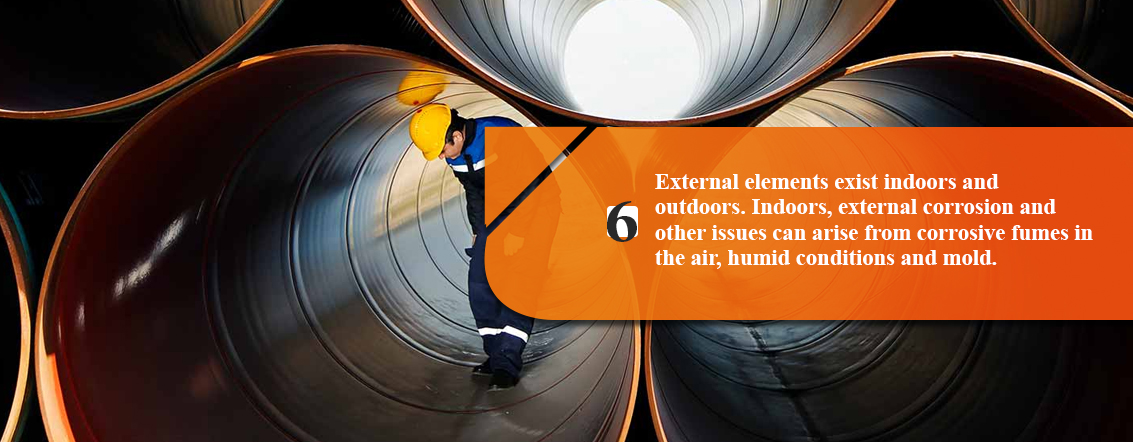
6. Exposure to External Elements
External elements exist indoors and outdoors. Indoors, external corrosion and other issues can arise from corrosive fumes in the air, humid conditions and mold. Outside poses several threats for external corrosion and damage, including the salt in seawater, inclement weather, microorganisms, plant overgrowth and more.
If any part of your fluid handling system is exposed outdoors, you need piping material that can withstand environmental elements. External elements that could lead to the deterioration or corrosion of your fluid handling piping include UV light, corrosive soil, precipitation and other atmospheric conditions.
Examples of external elements to be cautious of include the following:
- Corrosive fumes or vapors in the air from other work stations or materials
- Extreme or fluctuating temperatures, both indoors and outdoors
- Mold and mildew growth
- Salt from seawater
- Inclement weather, including rainfall, snow, lightning and hail
- Micro- and non-microorganisms that can burrow or corrode
- Plant, root and moss growth on outdoor piping
- Exposure to UV rays from the sun
- Corrosive and damp soil
7. Valve and Fitting Sizes
Certain piping materials will only have a few valve and fitting sizes to choose from, so you may need to eliminate some options based on this factor. Some of the valve and fitting types you can choose from include:
- Butterfly valves
- Ball valves
- Check valves
- Diaphragm valves
- Rupture pin safety valves
- Knife gate valves
- Solenoid valves
- Slurry valves
- Severe service valves
- Sanitary valves
The types of valve and fittings you choose will depend upon the types of connections you’ll need to make from pipe to pipe, as well as to connect the pipes to other features of the fluid handling system.
8. The Cost of the Material
Cost is a significant factor in any business decision. As you consider different pipe materials, keep in mind the cost of:
- The initial investment in all required parts, including the pipes, valves and pipe fittings
- Whether your chosen material is readily available or needs to be imported
- Routine and emergency maintenance appointments
- Pipe lining materials, if applicable
As with any expense, always consider the return on investment when comparing different costs. For example, if a pipe material is best suited for your industry due to its thermal regulation and durability, but it is more expensive, keep in mind the potential loss you might face if choosing a cheaper, less viable option. For many industries, not investing in the right pipe materials can lead to much more costly issues down the road. Always keep your industry’s non-negotiable needs in mind when examining costs.
Types of Piping Material Available
Now that you know what factors will affect the piping material you should choose, let’s talk about six of the most popular piping materials, as well as the conditions that each of them would work best for.
1. Cast Iron

Cast iron was one of the earliest materials used for piping, and it’s most commonly found in underground applications. Piping that carries materials like water, gas and sewage underground must be incredibly durable, pressure-resistant and long-lasting since these pipes must last for several decades without having to be replaced. Soil pipes are also commonly made using cast iron due to its excellent corrosion-resisting properties. Cast iron pipes are more popular in apartment buildings rather than private dwellings due to its fire resistance and noise-dampening qualities.
If you need underground piping at your facility that will last as long as possible, cast iron may be the best material for your fluid handling system.
2. Steel and Steel Alloys
Carbon steel pipes and steel alloys are created using different manufacturing methods to provide multiple piping material options all made from steel. Steel is a desirable piping material because of its thickness and ability to contain highly pressurized fluids. Two common types of steel piping materials for manufacturing facilities are:
- Carbon steel pipes: Carbon steel pipes are available in several different grades depending on the amount of carbon the pipe contains. This type of steel piping is more subject to corrosion than other varieties, making it ideal for indoor systems transporting non-corrosive materials.
- Galvanized steel: The second option for steel piping is galvanized steel, which is better equipped to handle corrosive fluids, as well as high-temperature materials. However, it is not as ideal for high-pressure substances, as it is rated only for pressures of up to 250 psi.
3. Nonferrous
The category of nonferrous pipe materials refers to any piping material that is a metal other than steel. Popular options for nonferrous metals include:
- Brass: Brass piping is popular for the transportation of corrosive materials, and the most common type is red brass.
- Aluminum: Several varieties of aluminum piping exist based on the type and amount of alloy added to the aluminum. The level of aluminum pipe you choose will be dependent on whether you’re transporting highly corrosive or high-pressure materials.
- Copper: Copper piping is standard for both commercial and residential water applications, such as plumbing and other waterlines. You can choose between several types of copper piping based on thickness.
- Copper-nickel: Copper-nickel piping is most commonly used in marine and offshore applications for its excellent ability to transport seawater effectively and with minimal corrosion. As a durable pipe material option, copper-nickel can also handle materials of high temperatures.
4. Concrete
The most typical application for concrete pipes is in large-scale engineering projects such as water resource management and stormwater control. Depending on the diameter of the pipe, concrete pipes are typically reinforced with another layer or durable wire to allow it to maintain its strength underground. Concrete pipes used for civil purposes must pass several destructive tests to ensure they can withstand any potentially disastrous occurrences.
These pipes must also be regularly maintained, as dirt and debris can easily stick to the insides of concrete pipes and cause a backup. Depending on the type of material the pipes are carrying, a sewage or stormwater backup could be very hazardous to the surrounding areas. Most manufacturing facilities would not benefit from using concrete piping for their fluid handling systems.
5. Plastic
Plastic pipes are an option you may seriously consider for your facility’s fluid handling system. Options for plastic pipes include:
- PVC: Polyvinyl chloride (PVC) pipes are the most widely used type of plastic piping, ideal for both structural and electrical applications.
- Polypropylene: Polypropylene pipes are most effective and appropriate for transporting chemical waste and other highly corrosive materials.
- Polyethylene: Polyethylene is a flexible but strong material that is best for piping in irrigation, sprinkler and other water-related applications.
- PEX: PEX pipes are essentially polyethylene pipes that have been processed to be both stronger and more resistant to hot and cold temperature changes. This material is becoming a significant alternative to traditional copper pipes.
- ABS: You’ll find ABS pipes in sewer, waste, drain and vent applications.
6. Lined Pipe
We saved the best type of pipe for most industrial and manufacturing systems for last — lined pipe and fittings are recommended for fluid handling systems in most facilities. Plastic-lined steel pipe is essentially the “best of both worlds,” combining the corrosion-resisting qualities of plastic with the durability of metal materials. You can choose which type of plastic material you want your steel pipes to be lined with. Popular choices for plastic-lined pipe and fittings include:
- Polyvinylidene Fluoride (PVDF): When you’re transporting high-strength acids and other corrosive liquids, opting for PVDF-lined pipe and fittings is a durable choice. These pipes are designed to withstand the corrosive properties of fluids involved with chemical processing and electronics manufacturing.
- Fluoropolymer (PTFE): PTFE-lined pipe and fittings are known for their ability to transport fluids at high temperatures and pressures. Its strength and corrosion-resistance make it a popular piping material for many industrial applications.
- Polypropylene (PP): PP-lined pipe is the best choice for handling basic fluids with low chemical makeup and low to no corrosive qualities. It’s the most economical option for small-scale operations and transporting liquids at an average temperature.
Benefits of Adding Thermoplastic-Lined Pipe to Your Operation
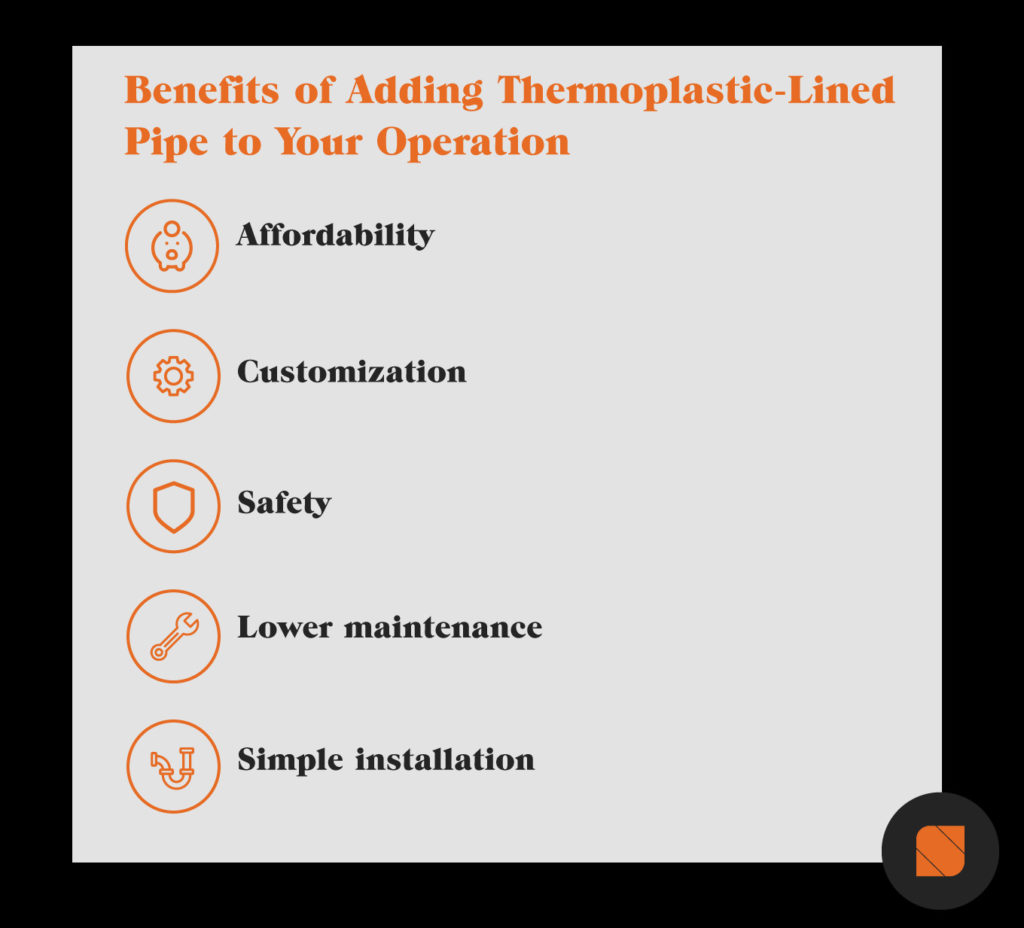
For most standard manufacturing facilities and other industrial applications, there are several benefits of plastic-lined pipe and fittings. Some of the most notable advantages of this type of pipe material include:
- Affordability: By combining the excellent resistance properties of plastic lining to the low cost of steel and other metallic materials, thermoplastic-lined pipe and fittings are one of the most affordable piping options for many manufacturing facilities.
- Customization: By adjusting the amount of each material used, you can customize the properties of your lined pipe while still benefiting from each material’s most desirable characteristics.
- Safety: Plastic-lined pipes lead to improved product quality thanks to the lack of contamination from the liquid touching metallic materials. They are also less likely to result in the fouling of materials and the costly downtime that comes along with the cleanup and repair process.
- Lower maintenance: Thermoplastic-lined pipe is resistant to corrosion and chemicals, and it also does not require frequent maintenance or cleaning.
- Simple installation: When installation technicians have been trained properly, lined pipe installation is much simpler, faster and affordable than installing metal pipes.
Which Pipe Material Is Best for Fluid Handling Operations?
To find the best pipe material for fluid handling operations, you must consider several factors about your facility and your fluid handling system. Every manufacturing facility is unique and requires pipe material and fittings for differing applications. When it comes time for you to replace your fluid handling system, be sure to consider each choice carefully and not just do what everyone else may be doing. Just because metal pipe liners work for one facility, for example, does not mean they are also the best choice for yours.
That being said, lined pipe material is often the best solution for most average-sized manufacturing facilities, as it combines the best features of the two most popular small-scale choices — plastic and metal.
Get Custom Pipe and Fittings From SEMCOR
Once you’ve decided which pipe material and fittings might be best for your operation, contact the experts at SEMCOR to start the process of getting them into your building or buildings. We offer the best products for custom fluid handling, including pipe and fittings, valves, hoses and other custom solutions. Plus, all our products are designed with durability in mind, minimizing the need for future maintenance or an early replacement. We can also provide assistance in choosing the right materials based on your facility’s system and needs.
SEMCOR offers a wide range of fluid handling solutions and customizations, including:
- Pipe and pipe fitting fabrications: SEMCOR specializes in rigid piping designed to withstand high-temperature and corrosive environments. We also provide high-quality and standard plastic pipe linings and fittings, including PTFE, ATL PTFE, PVDF and PP lining. If you require custom lining and fabrications, SEMCOR is here to help.
- Hose and valve modifications: SEMCOR offers hoses made of PTFE, metal, rubber and plastic. We also provide PTFE hose crimp fittings, rubber hose clamping fittings and metal hose welding fittings, so each product can be modified to meet your exact specifications. Our valves, actuators and controls come from top industry suppliers and are made of strong, corrosion-resistant plastics so they can withstand the most abrasive fluid transfer. Our design and fabrication options also allow us to create customized valves, actuators and control solutions for any industrial application.
- Custom expansion joints: SEMCOR provides customizable metal and rubber expansion joints from top industry brands like Resistoflex and Hose Master.
Since 1907, SEMCOR has remained committed to answering your questions and delivering nothing but top quality fabrications for your business. To learn more about SEMCOR fluid handling products and services, or to request a quote, reach out to us online or at (314) 300-0432.
Both our service and sales teams are available 24/7 to assist you and answer any questions you may have. Get in touch with us today, or keep browsing our site to learn more about our fluid handling solutions, including our high-quality lined pipe and fittings.




